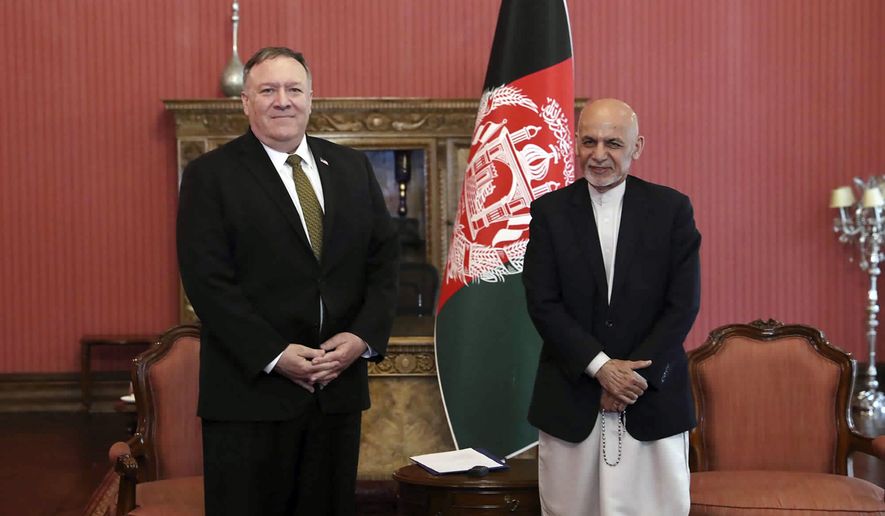The Trump administration’s proposed Afghan peace deal in Afghanistan has been thrown further into question by a wave of Taliban attacks that have killed dozens of Afghan security forces while a prisoner exchange at the heart of the peace push remains stalled.
A spike in attacks in Afghanistan’s north and south suggests the Taliban’s commitment to a “reduction in violence” pact tied to an initial peace deal with U.S. officials last month has all but dissolved in recent days.
While there have been no direct attacks on U.S. troops, regional analysts say Taliban leaders are clearly testing Washington’s tolerance and may be planning more brazen assaults to coincide with an annual spring offensive that typically begins in early April.
The attacks come less than a week after Secretary of State Mike Pompeo flew to Kabul to try and staunch division in the U.S.-backed Kabul government there that has threatened to derail the administration’s plan to withdraw American troops from Afghanistan.
A Feb. 29 U.S.-Taliban agreement called for the militant group and the Kabul government to start direct talks and release prisoners as a confidence-boosting measure.
But neither the swap nor the negotiations have occurred amid a feud between Afghan President Ashraf Ghani and his chief political rival Abdullah Abdullah. Mr. Pompeo’s visit last week failed to mediate the fight and Mr. Pompeo subsequently announced plans to cut $1 billion in assistance to Afghanistan if the two men can’t “get their act together.”
Mr. Ghani then announced 21-member team to begin formal talks with the Taliban, only to have Mr. Abdullah reject the team as not inclusive enough. By Monday, local news outlets were reporting that the first prisoner swap slated for March 31 was off as well.
The Trump administration and U.S. military officials in Afghanistan were quiet Monday about the latest developments.
A key piece of the initial U.S.-Taliban deal was a commitment by Taliban leaders to deny space in Afghanistan to other terror groups. Last week saw the Islamic State’s branch in Afghanistan claim responsibility for an attack on a Sikh house of worship that killed 25 people.
More recently, as many as 30 Afghan security forces have been killed in ambushes or direct clashes with Taliban fighters since Saturday.
The Taliban have not claimed responsibility for the attacks. But Afghan officials say the militants have targeted a military checkpoints in southern Zabul province and northern Baghlan province. Taliban fighters are reported to have separately stormed the compound of a top police officer in the northeastern province of Takhar and carried out a range of attacks in several other provinces.
Ashley Jackson, a researcher with the London-based Overseas Development Institute, said that following a brief reduction in violence last month, the Taliban returned to a status quo of nearly two dozen attacks a day, while refraining from targeting U.S. forces.
“There’s been a high degree of strategic ambiguity around expectations that the Taliban would reduce violence,” Ms. Jackson said Monday on a video conference hosted by the Wilson Center think tank. The Taliban “seems to have correctly calculated how much violence they can actually get away with — which is to say they can get away with a pretty high level.”
Laurel Miller, a former U.S. diplomat focused on Afghanistan who now heads the Asia Program at the International Crisis Group, suggested the Trump administration should be prepared to put a “neutral mediator” in charge of the Afghan peace talks.
“Obviously, Iran and China are essential participants in any kind of regional support group and obviously U.S. relations with both Iran and China are, shall we say, not at their best at the moment,” she said. “So, another government would be in a better position to create a group that the U.S. should also be a part of but isn’t the leading force in.”
An ICG analysis published Monday suggested the Taliban’s hard negotiating line may change if intra-Afghan talks actually get underway.
“The fundamental question, however, is whether the Taliban are willing to compromise on substantive issues of power sharing, a future political structure, governance and rules for public life,” the analysis said.
Under the U.S.-Taliban peace deal, American troops would be cut from current levels of between 12,000 and 13,000 to about 8,600 in the next several months. Mr. Pompeo said last week that U.S. officials are going to “watch the conditions” and “continue to evaluate that as we move forward.”
“I’m still optimistic,” the secretary of state said. “Time is of the essence.”
χ This article is based in part on wire service reports.
• Guy Taylor can be reached at gtaylor@washingtontimes.com.




Please read our comment policy before commenting.